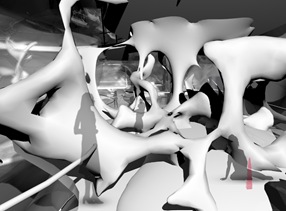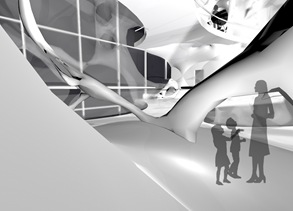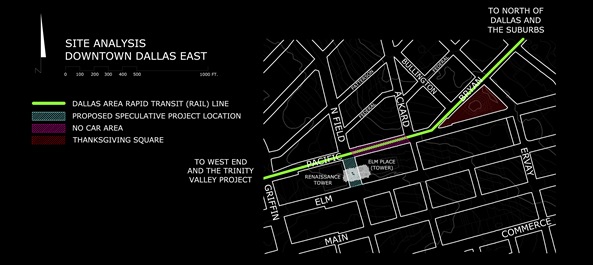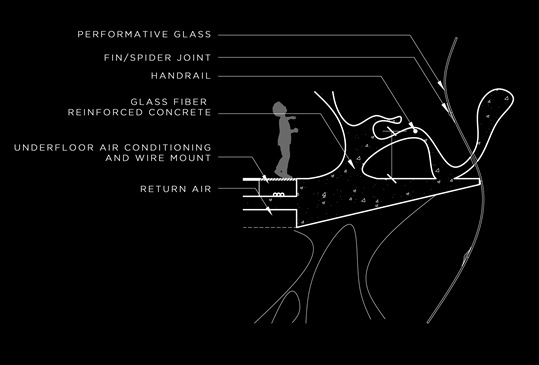
**This is the completed project of the original mid-term project that I posted earlier this semester.
**Also see the first project for the semester (just posted) named thinkering space.
“Education is not something which the teacher does. It is a natural process which develops spontaneously.”- -Maria Montessori The Absorbent Mind-
For this project, we were asked to design a school based around the teachings of Maria Montessori. For me, the contribution of architecture to a non-linear educational approach was quite appealing. The concept of non-linearity really had to do with shaping the logic of the form, or really shaping the phenomenon of fluids (ie particulate matter) in such a way as to create topological conditions which connect what would typically be the disparate indexical elements of the building. Therefore, the architecture should reflect the ideology: more linear, standardized, compartmentalized pedagogical programs are best expressed through disparate parts - parts that seemingly work together at some compositional level but really never truly interact. Because the Montessori method is based more on the drive of the individual and not the overall, top-down design of the typical American education program, a different logic is necessary. In this particular study, I used fluids to equate with a more fluid, or more interpersonal approach to education.
There were a number of elements that had to be considered for the completion of the work. This was a particularly important project architecturally speaking because of its references to more fluid precedent such as the Baroque. The uncalculated logic of fluids creates what is called a "painterly effect" and is perhaps best seen through the juxtaposition between the modern skyscraper boxes and the school (see below). We can understand modernism then as being representational of the high-renaissance - very calculated, calming, proportional, and what not; while what I have done addresses a new emerging trend in architecture, one that reacts to the tired aesthetic of Modernism.
As for the site itself, the project is located in a very specific location in Dallas, between the Elm Place and Renaissance Tower (how suiting). I chose this location for a number of reasons: the connectivity to public transportation, the proximity to density, and the reclamation of urban interstitial spaces (such as the Wozoco project by MVRDV); as well as the relative proximity to Thanksgiving Square, the West End, and the proposed Trinity River Corridor Project. Also, it should be noted that at the base of the tower, at the public drop off, there is a no-car zone, the only one that I know of in the downtown area.
The two towers have 12.5' floor to floor heights, therefore I've continued this trend so that the new school can cleanly integrate with the existing buildings for life safety considerations. I've also located the project lower to the ground and am proposing stronger "loose" joint between the three buildings, similar to those used in earthquake zones, as to not compromise the independent structural state of each building.
The “netting” acts to weave the buildings together monolithically with the slabs using the non-linear tensile material glass fiber reinforced concrete. The tensile strength of such a material is 4710 MPa at failure, almost 12 times that of your standard A36 steel. This material coupled with strong, lightweight concrete provides a solution that allows for such a site condition to exist.
As for the building itself, there are a total of five floors, each providing pods of programmatic elements. The first floor contains the main entrance, the administration offices, and the toddler space. The age continues to increase with floor size all the way up to the top story which is programmed to be a mixed use facility incorporating painting, music, art, and PE. The upper story will be visually open to the sky, while the performative glass shields the students from heat and the bulk of the radiation - think transition lenses for a building. Also note that many of the programmatic elements, such as restrooms, will have to have frosted glass as facade instead of the regular performative glass.
In conclusion, I will leave you with the following quotes: According to Jesse Reiser "Atmosphere and affect are aspects that the architect has traditionally maintained the agency controls. In fact, affect is a highly determined feature of architecture, whereas much of the importance ascribed to program is intractable - like sand going through your fingers. The affective dimension of architecture not only influences use; at the level of order it also describes zones of intensity that, while real, nevertheless may be experienced in wildly divergent ways. Program by contrast limits these. As (a) measure of people's practices, rather than what architecture can do, programming is a drain on freedom, on the possibility for selection, and thus on information.
Ben Van Berkel and Caroline Bos continue such logic "Effects are actions and they emanate from relations. The best effects which architects can produce in the contemporary world are those that are proliferating and moving, effects that are anticipatory, unexpected, climactic, cinematic, time-related, non-linear, surprising, mysterious, compelling, and engaging."
upper level typical learning space | toddler typical learning space


program & site

facade condition

typical section
animation showing walkthrough on the upper floor







